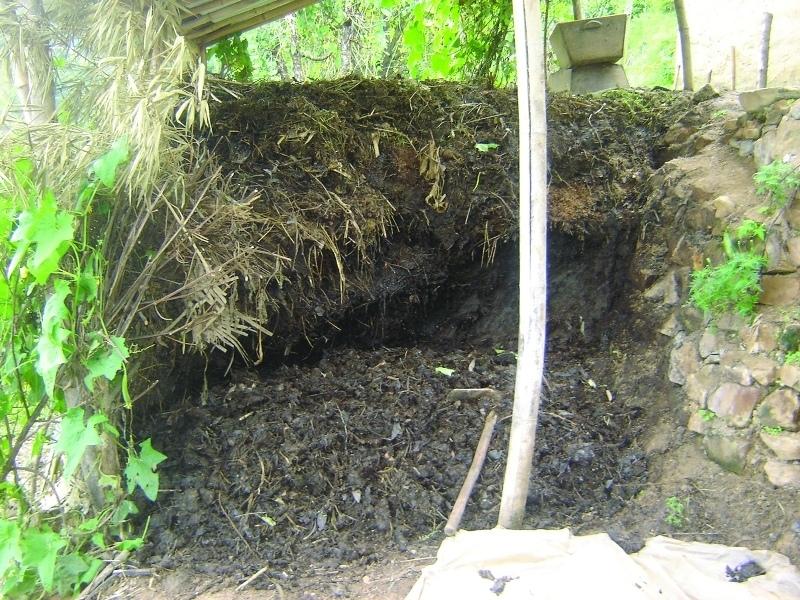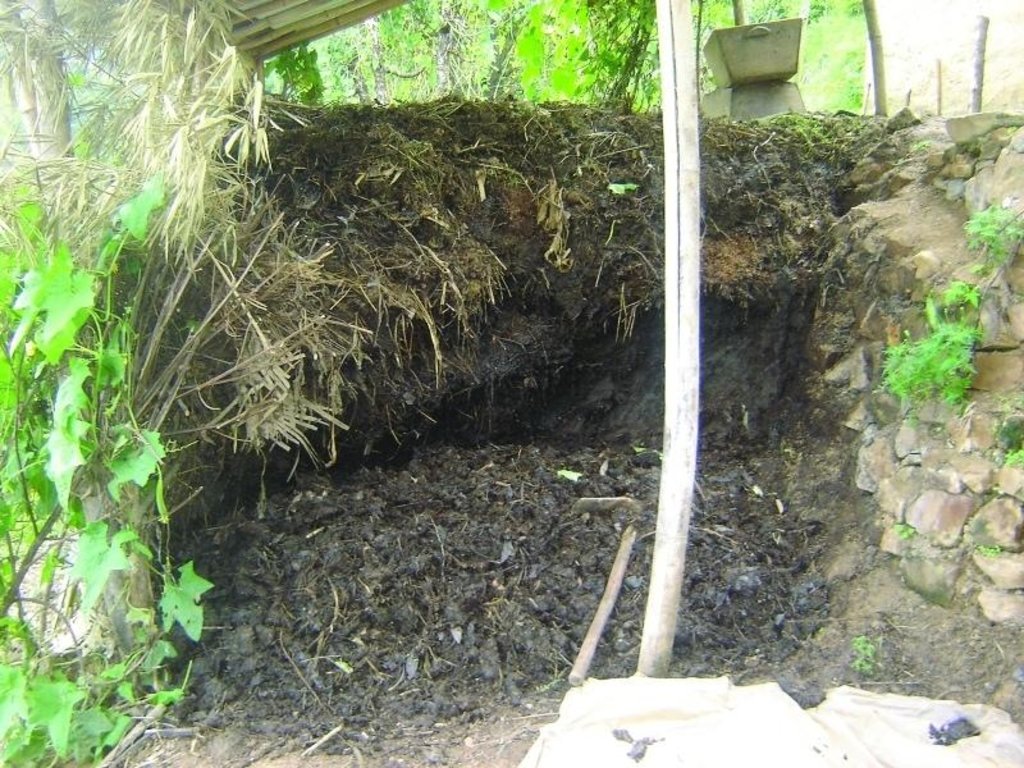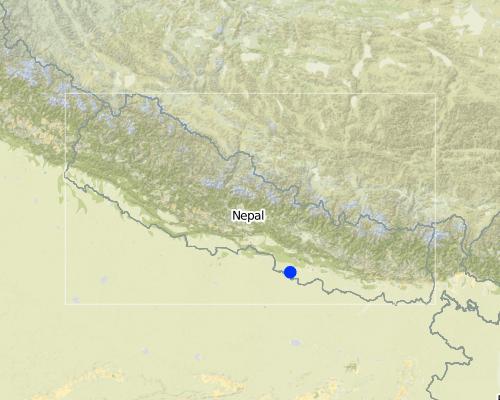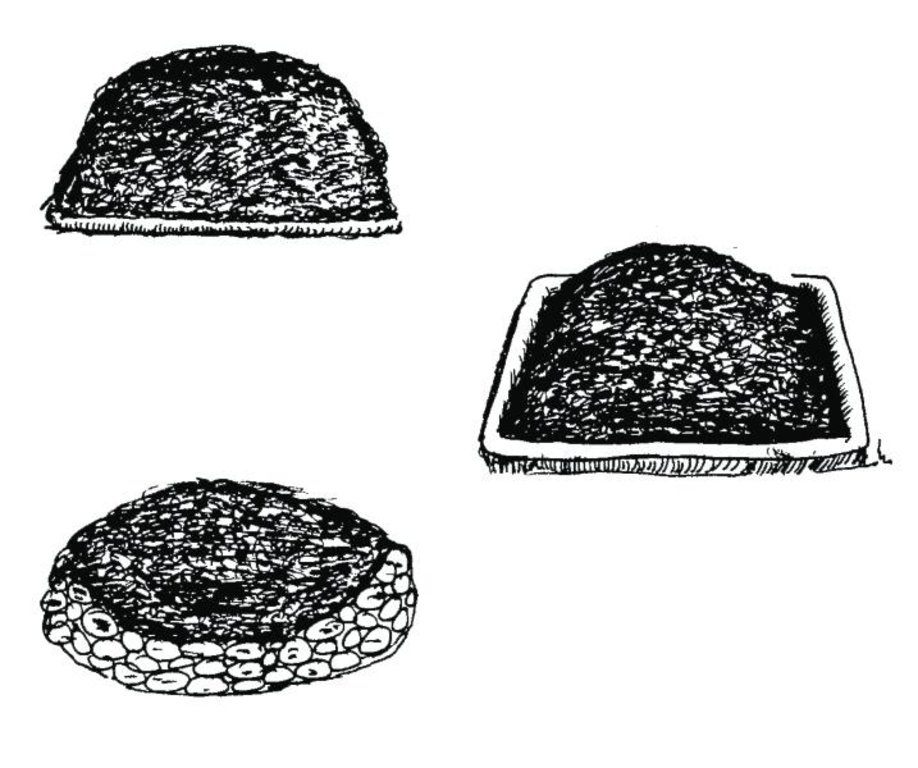Better quality farmyard manure through improved decomposition [النيبال]
- تاريخ الإنشاء:
- تحديث:
- جامع المعلومات: Richard Allen
- المحرر: –
- المُراجع: David Streiff
Upayukta bighatan prakriya dwara ramro gunastar ko gothemal (Nepali)
technologies_1759 - النيبال
عرض الأقسام
توسيع الكل طي الكل1. معلومات عامة
1.2 تفاصيل الاتصال بالأشخاص الرئيسيين لمصدر المعلومات والمؤسسات المشاركة في تقييم وتوثيق التقنية
متخصص في الإدارة المستدامة للأراضي:
Director
+977 1 5520314
Soil Management Directorate, Department of Agriculture
النيبال
متخصص في الإدارة المستدامة للأراضي:
Team Leader
+977 1 5543591
ssmp@helvetas.org.np
Sustainable Soil Management Programme
GPO Box 688, Kathmandu/Nepal
النيبال
اسم المشروع الذي سهّل توثيق/تقييم التقنية (إذا كان ذلك على صلة)
Sustainable Soil Management Programme, Nepal (SSMP)اسم المؤسسة (المؤسسات) التي سهلت توثيق/تقييم التقنية (إذا كان ذلك على صلة)
Department of Agriculture, Soil Management Directorate, Hariharbhawan Lalitpur (doasoil) - النيبالاسم المؤسسة (المؤسسات) التي سهلت توثيق/تقييم التقنية (إذا كان ذلك على صلة)
HELVETAS (Swiss Intercooperation)1.3 الشروط المتعلقة باستخدام البيانات الموثقة من خلال WOCAT
متى تم تجميع البيانات (ميدانيا)؟:
07/11/2008
يوافق جامع المعلومات والشخص (لاشخاص) الرئيسي لمصدر المعلومات على الشروط المتعلقة باستخدام البيانات الموثقة من خلال WOCAT:
نعم
1.5 الإشارة إلى الاستبيان (الاستبيانات) حول مناهج الإدارة المستدامة للأراضي

Farmer field schools on integrated plant nutrient systems [النيبال]
Participatory and collaborative learning through the farmer field school approach
- جامع المعلومات: Richard Allen

Farmer-to-farmer diffusion [النيبال]
Wider diffusion of sustainable soil management technologies through a demand responsive farmer-to-farmer diffusion approach
- جامع المعلومات: Richard Allen
2. وصف تقنيةالإدارة المستدامي للأراضي
2.1 وصف مختصر للتقنية
تعريف التقنية:
Collection and proper storage of farmyard manure in heaps or pits
2.2 وصف تفصيلي للتقنية
الوصف:
Farmyard manure - a varying mixture of animal manure, urine, bedding material, fodder residues, and other components - is the most common form of organic manure applied in the midhills of Nepal. Farmyard manure has a high proportion of organic material which nurtures soil organisms and is essential in maintaining an active soil life. Only about half of the nutrient content of farmyard manure becomes available for crop growth during the first year after it has been applied to the soil - the rest is channeled through soil biotic processes and the nutrients are released in the following years. The high organic matter content and the active soil life improve or maintain friable soil structures, increase the cation exchange capacity, water holding capacity, and infiltration rate, and reducing the risk of soil pests building up.
Indigenous methods of preparing and using farmyard manure vary widely depending on the ecological zone, access to bedding material from crop or forest land, access to crop residues and fodder, labour availability, and other factors. A prerequisite for the manure having a positive impact on soil fertility is that it is properly decomposed. The application of partially decomposed manure can increase the number of white grubs, red ants and other soil pests.
Decomposition is enhanced and the time it takes to happen is reduced if the manure is kept warm and moist (but not wet) at all times. Heaping the manure up or storing it in a pit helps. Whether it is best to heap up the manure or put it in a pit depends on the local climate. Heaping has the advantage of being less costly, while the pit method reduces runoff and the loss of nutrient rich fluids. Adding nitrogen in the form of urine (N) improves the carbon to nitrogen ratio.
2.3 صور التقنية
2.5 البلد/المنطقة/المواقع التي تم تنفيذ التقنية فيها والتي يغطيها هذا التقييم
البلد:
النيبال
مزيد من التفاصيل حول الموقع:
Midhills districts of Nepal
Map
×3. تصنيف تقنية الإدارة المستدامي للأراضي
3.1 الغرض الرئيسي ( الأغراض الرئيسية) للتقنية
- Access to manure
3.2 نوع (أنواع) استخدام الأراضي الحالية حيث يتم تطبيق التقنية

الأراضي الزراعية
- زراعة سنوية
التعليقات:
Major land use problems (compiler’s opinion): Intensifying cultivation practices with either 1) inadequate application of fertilisers leading to a decline in soil fertility and the mining of soil nutrients or 2) application of too much fertiliser causing environmental problems through excessive leaching, and losses of fertiliser in surface runoff and consequent eutrophication or nitrification of streams, ponds or groundwater.
3.4 مجموعةالإدارة المستدامة للأراضي التي تنتمي إليها هذه التقنية
- الإدارة المتكاملة لخصوبة التربة
3.5 انتشار التقنية
حدد انتشار التقنية:
- يتم تطبيقها في نقاط محددة/ تتركز على مساحة صغيرة
3.6 التدابير التقنية في مجال إلادارة المستدامة للأراضي

التدابير الإدارية
- M2: تغيير في مستوى الإدارة/الكثافة
3.7 الأنواع الرئيسية من تدهور الأراضي التي تناولتها التقنية

التدهور الكيميائي للتربة
- (Cn): تراجع الخصوبة وانخفاض محتوى المادة العضوية (غير ناتج عن الانجراف)
3.8 منع أو حد أو عكس تدهور الأراضي
تحديد هدف التقنية فيما يتعلق بتدهور الأراضي:
- الحد من تدهور الأراضي
4. المواصفات الفنية، وأنشطة التنفيذ، والمدخلات، والتكاليف
4.1 الرسم الفني للتقنية
4.2 المواصفات الفنية/شروحات الرسم الفني
a) Heap method
b) Pit method
c) Semi-pit method
The method should be chosen that
is most convenient and provides the
most favourable environment for
decomposition of the manure.
Generally heaps and pits are about 1 to 2m in diameter
depending on the amount of
manure produced and required.
Technical knowledge required for field staff / advisors: low
Technical knowledge required for land users: low
Main technical functions: increase in organic matter, increase in soil fertility, increase in soil productivity
Secondary technical functions: increased infiltration rate and water holding capacity, improved soil physical properties
Layout change according to natural and human environment: heaping or storage in pits
4.3 معلومات عامة بخصوص حساب المدخلات والتكاليف
حدد العملة المستخدمة لحساب التكاليف:
- دولار أمريكي
اذكر متوسط تكلفة أجر العمالة المستأجرة في اليوم الواحد:
2.00
4.4 أنشطة التأسيس
| النشاط | نوع التدبير | التوقيت | |
|---|---|---|---|
| 1. | Dig a 1m deep and 2m diameter pit using a shovel or spade. | إدارية | |
| 2. | Pit method: Put dung mixed with leaf litter, bedding material and fodder residues in the pit until it is full. | إدارية | |
| 3. | Apply urine directly over the manure heap using a plastic pipe or jug. | إدارية | |
| 4. | Cover the heap with a fine layer of straw, mud, soil or plastic sheet or any other suitable local materials to protect it from direct sunlight and excessive water. | إدارية |
4.5 التكاليف والمدخلات اللازمة للتأسيس
| تحديد المدخلات | الوحدة | الكمية | التكاليف لكل وحدة | إجمالي التكاليف لكل مدخل | % من التكاليف التي يتحملها مستخدمو الأراضي | |
|---|---|---|---|---|---|---|
| العمالة | Preapring manure pit | Persons/day | 1,0 | 2,0 | 2,0 | 100,0 |
| إجمالي تكاليف إنشاء التقنية | 2,0 | |||||
4.6 الصيانة/الأنشطة المتكررة
| النشاط | نوع التدبير | التوقيت/الوتيرة | |
|---|---|---|---|
| 1. | About one month after beginning to collect and pile up the material, turn | إدارية | |
| 2. | Depending on the location, it takes about 3-4 months to prepare fully decomposed farmyard manure. | إدارية |
4.7 التكاليف والمدخلات اللازمة للصيانة/للأنشطة المتكررة (سنويًا)
| تحديد المدخلات | الوحدة | الكمية | التكاليف لكل وحدة | إجمالي التكاليف لكل مدخل | % من التكاليف التي يتحملها مستخدمو الأراضي | |
|---|---|---|---|---|---|---|
| العمالة | Decompose manure | Persons/day | 1,0 | 2,0 | 2,0 | 100,0 |
| إجمالي تكاليف صيانة التقنية | 2,0 | |||||
التعليقات:
Cost as in January 2007
4.8 أهم العوامل المؤثرة على التكاليف
قدم وصفا لأهم العوامل التي تؤثر على التكاليف:
The heap method is cheaper, as no digging is involved
5. البيئة الطبيعية والبشرية
5.1 المناخ
هطول الأمطار السنوي
- < 250 مم
- 251- 500 ملم
- 501 - 750ملم
- 1,000-751 ملم
- 1,500-1,100 ملم
- 2,000-1,500 ملم
- 3,000-2,001 ملم
- 4,000-3,100 ملم
- > 4000 ملم
المواصفات/التعليقات على هطول الأمطار:
Annual rainfall: Also 2000-3000 mm
المنطقة المناخية الزراعية
- رطبة
Thermal climate class: subtropics
5.2 طوبوغرافيا
متوسط الانحدارات:
- مسطح (0-2%)
- بسيط (3-5%)
- معتدل (6-10%)
- متدحرج (11-15%)
- تلال (16-30%)
- شديدة الانحدار(31-60%)
- فائقة الانحدار (>60%)
التضاريس:
- هضاب/سهول
- أثلام مرتفعة
- المنحدرات الجبلية
- منحدرات التلال
- منحدرات في السفوح
- قاع الوادي
المنطقة الارتفاعية:
- 100-0 متر فوق سطح البحر
- 500-101 متر فوق سطح البحر
- 1,000-501 متر فوق سطح البحر
- 1,500-1,001 متر فوق سطح البحر
- 2,000-1,501 متر فوق سطح البحر
- 2,500-2,100 متر فوق سطح البحر
- 3,000-2,501 متر فوق سطح البحر
- 4,000-3,001 متر فوق سطح البحر
- > 4000 متر فوق سطح البحر
التعليقات والمواصفات الإضافية بشأن التضاريس:
Slopes on average: Also moderate (6-10%), rolling (11-15%) and hilly (16-30%)
Landforms: Also footslopes
Altitudinal zone: Also 1000-1500 m a.s.l., 1500-2000 m a.s.l. and 2000-2500 m a.s.l.
5.6 خصائص مستخدمي الأراضي الذين يطبقون التقنية
التوجه السوقي لنظام الإنتاج:
- الكفاف (الإمداد الذاتي)
- مختلط (كفاف/ تجاري)
أفراداً أو مجموعات:
- فرد/أسرة معيشية
اذكر الخصائص الأخرى ذات الصلة لمستخدمي الأراضي:
Off-farm income specification: In most farm households, off-farm income plays at least a minor and increasingly a major role. Occasional opportunities for off-farm income present themselves in the form of daily labour wages. Some households’ members receive regular salaries, whilst an increasing number of Nepalis are working in India, the Middle East, Malaysia, and elsewhere and sending remittance incomes home.
Market orientation of production system: Also commercial/ market
5.7 متوسط مساحة الأرض المملوكة أو المستأجرة من قبل مستخدمي الأراضي الذين يطبقون التقنية
- < 0.5 هكتارا
- 0.5 - 1 هكتار
- 1 -2 هكتار
- 2 - 5 هكتار
- 5 - 15 هكتار
- 15 - 50 هكتار
- 50 - 100هكتار
- 500-100 هكتار
- 1,000-500 هكتار
- 10,000-1,000 هكتار
- > 10,000 هكتار
5.8 ملكية الأراضي، وحقوق استخدام الأراضي، وحقوق استخدام المياه
ملكية الارض:
- فردية، لا يوجد سند ملكية
- فردية، يوجد سند ملكية
حقوق استخدام الأراضي:
- مؤجر
- فردي
التعليقات:
sharecropping between owner and tenant
6. الآثار والتصريحات الختامية
6.1 الآثار التي أظهرتها التقنية في الموقع
الآثار الاجتماعية والاقتصادية
الإنتاج
إنتاج المحاصيل
الدخل والتكاليف
النفقات على المدخلات الزراعية
التعليقات/ حدد:
Reduced cash expenses on agrochemicals (fertilisers, pesticides; substituted by labour)
آثار اجتماعية واقتصادية أخرى
Cleaner environment around houses if manure heap or pit is well maintained
الآثار الايكولوجية
الآثار الايكولوجية الأخرى
Incidence ofsoil pests (white grub, red ant)
Application of mineral fertilisers
6.2 الآثار التي أظهرتها التقنية خارج الموقع
تلوث المياه الجوفية/الأنهار
التعليقات/ حدد:
Reduced influx of nutrients into water bodies
Dependence on outside inputs
6.4 تحليل التكلفة والعائد
كيف يمكن مقارنة العوائد نسبة لتكاليف الإنشاء (من وجهة نظر مستخدمي الأراضي)؟
عوائد قصيرة الأجل:
إيجابي
عوائد طويلة الأجل:
إيجابي
كيف تتم مقارنة العوائدمع كلفة الصيانة/التكاليف المتكررة (من وجهة نظر مستخدمي الأراضي)؟
عوائد قصيرة الأجل:
إيجابي
عوائد طويلة الأجل:
إيجابي
التعليقات:
The high costs of mineral fertiliser mean that the establishment costs are recovered quarterly. Over the long-term, the major reduction in costs leads to large benefits.
6.5 اعتماد التقنية
التعليقات:
Comments on acceptance with external material support: Heap and pit methods have been very well accepted and adopted widely ( 60-70% ) of among participants in SSMP.The semi-pit method is not as accepted as the other methods due to its high initial establishment costs.
6.7 نقاط القوة / المزايا / الفرص التي توفرها التقنية
| نقاط القوة/ المزايا/ الفرص من وجهة نظر جامع المعلومات أو غيره من الاشخاص الرئيسيين لمصدر المعلومات |
|---|
|
The use of improved and well-decomposed farmyard manure reduced the need for mineral fertiliser and pesticides thereby reducing production costs, cash expenditure, and outside dependency How can they be sustained / enhanced? Further promote the technology to increase this impact. |
| The use of fully decomposed farmyard manure reduces pest incidence, especially attacks of red ants and white grubs |
6.8 نقاط ضعف / مساوىء / مخاطر التقنية وسبل التغلب عليها
| نقاط الضعف/ المساوىء/ المخاطر من وجهة نظر جامع المعلومات أو غيره من الاشخاص الرئيسيين لمصدر المعلومات | كيف يمكن التغلب عليها؟ |
|---|---|
| The initial establishment costs for building a semi-pit may hamper adoption |
Promote alternative methods of building a semi-pit without using cement and using local resources |
7. المراجع والروابط
7.2 المراجع للمنشورات المتاحة
العنوان، المؤلف، السنة، النظام القياسي الدولي لترقيم الكتب ISBN:
STSS; SSMP (2001) Farmyard Manure and Compost Management (in Nepali) Kathmandu: Soil Testing Services Section, Department of Agriculture and Sustainable Soil Management Programme
متاح من أين؟كم التكلفة؟:
SSMP
الروابط والوحدات المواضيعية
توسيع الكل طي الكلالروابط

Farmer field schools on integrated plant nutrient systems [النيبال]
Participatory and collaborative learning through the farmer field school approach
- جامع المعلومات: Richard Allen

Farmer-to-farmer diffusion [النيبال]
Wider diffusion of sustainable soil management technologies through a demand responsive farmer-to-farmer diffusion approach
- جامع المعلومات: Richard Allen
الوحدات المواضيعية
لا يوجد وحدات مواضيعية





